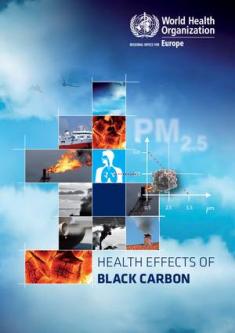 Health Effects of Black Carbon
Health Effects of Black CarbonThis report presents the results of the first systematic review of evidence of the health effects of black carbon (BC) – an important component of fine particulate matter (PM2.5) of which ambient air concentration notoriously exceed the WHO guidelines across the UNECE region.
Short-term epidemiological studies provide sufficient evidence for a link between daily variations in BC concentrations with short-term adverse health effects e.g. cardiopulmonary hospital admissions. Also, long-term average BC exposure has been directly linked to and cardiopulmonary and all-cause mortality. BC may not be a major directly toxic component of PM2.5, but it may operate as a universal carrier of a wide variety of chemicals of varying toxicity to the lungs, the body’s major defence cells and possibly the systemic blood circulation. Therefore, a reduction in exposure to PM2.5 containing BC and other combustion-related particulate matter material should lead to a reduction in the associated health effects. This was precisely one of the breakthroughs achieved in the revision of the Gothenburg Protocol adopted by the Parties to the Long-Range Transboundary Air Pollution Convention in May 2012.
This unique report has been elaborated by experts of the joint WHO/UNECE Task Force on Health Aspects of Air Pollutants under UNECE’s Long-Range Transboundary Air Pollution Convention (LRTAP). The Task Force is chaired by the representative of the WHO European Centre for Environment and Health, Bonn, WHO Regional Office for Europe. Readmore


